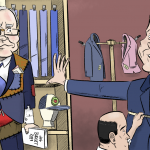No laughing matter: “The Death of Stalin” highlights Putin’s anxieties

Armando Ianucci’s dark comedy The Death of Stalin has caused controversy in Russia.
After a preview in the Ministry of Culture, a group of politicians and cultural figures – including the daughter of acclaimed WW2 military commander Marshal Georgy Zhukov – wrote an open letter to Culture Minister Vladimir Medinskii to withdraw permission for the film’s distribution in Russia. President Putin’s man for historical topics happily complied. The one cinema which defied the ban was ‘visited’ by police and dropped the movie from its programme.
Why was the movie banned? After all, it is a slapstick comedy about the power struggle after Stalin’s death, not a historical documentary. For example, the Great Terror of 1937-38 was moved to 1953, forming the backdrop to Stalin’s death and the ensuing power struggle. This was not a mistake. The film-makers were well informed and had been advised by a professional, Professor Polly Jones of Oxford University. The move was for dramatic effect.
As far as historical films go, then, the Death of Stalin is more like Monty Python’s Life of Brian (1979) or maybe Quentin Tarantino’s Inglourious Basterds (2009) than, say, Oliver Hirschbiegel’s Downfall (2004). Nobody would dismiss these movies for not correctly depicting the historical Jesus Christ, or for misrepresenting the cause of Hitler’s death.
An anxious Kremlin
The ban is best explained by the Kremlin’s anxieties about its grip on power. In reality, of course, there is barely a government in Europe as secure as Vladimir Putin’s. Independent polling has shown high approval ratings for the President, despite declining economic performance since 2013. The aggressive, Make-Russia-Great-Again stance in international relations has improved this popularity.
And yet, Putin must feel strangely insecure in his position as Tsar, God, and Commander of all the Russias. In the recent presidential election, the government decided it needed not only 70 per cent of votes, but also 70 per cent voter participation.
Clearly, there is a feeling in the Kremlin that holding power requires near-complete consent. And Team Putin left nothing to chance. Various inducements were provided, from free buffets to games for the children. Free transport to polling stations helped to get the vote out. Stooges stuffed ballot boxes, intimidated election observers and at times removed them by force.
In a country that’s not a totalitarian dictatorship, such desperate measures were guaranteed to be reported via social media, making a mockery of the pretence to democracy. They allowed the opposition, weak as it is, to claim that these were not legitimate elections.
And all this effort only to reach 70 & 70. The result fell short nevertheless. Not everybody, it turns out, loves Putin. While a record share (76.7 per cent) and number of voters (56.2 million) elected the President, official voter turnout was 67.5 per cent, the third lowest since the breakdown of the Soviet Union in 1991.
With this context in mind, we can return to the question of the reason for the ban of The Death of Stalin. According to the letter to Medinskii, the movie was a “slander on the history of our country, a malicious and absolutely inappropriate, so-called ‘comedy’, which is denigrating the memory of our citizens, who defeated fascism.” Moreover, the film was “extremist,” tried to “humiliate the dignity of the Russian (Soviet) person” and propagated discrimination “on the basis of social and national identity.”
This critique is missing the point. The Death of Stalin is not denigrating Russia or the Russians. It is denigrating power-hungry politicians, as one perceptive young Russian put it. She tasted the forbidden cinematographic fruit during a trip to Riga, easily reached by bus from St. Petersburg:
“I really liked the film, it’s insanely funny. But I immediately understood why it is now banned [in Russia]. … I cannot remember that in our cinema the topic of power in general has been treated with such an intonation, the topic of change of power and the mess which accompanies it.”
The leaders are shown as “completely inhuman,” she continued. Interested only in power “they completely forgot about the people, about the country,” the 26-year old observed.
She is right. The movie is a political satire targeting politicians, not ordinary people. It depicts the ruling clique as brutal buffoons, power-hungry, vulgar, and pathetic. They don’t care about the people they govern, whom they happily kill in droves if it suits their purposes.
Even the great Marshal Zhukov – whose depiction by Jason Isaacs is my personal favourite but could not have pleased the hero’s daughter – is violent, arrogant, and foul-mouthed.
According to the official Russian version of the Second World War, Stalin was a great leader whose firm hand led ‘Russia’ to victory in war. But in the film he is shown as both nasty and vulgar, indulging in late-night cowboy movies and encouraging inane pranks among his entourage.
After his breakdown, his body lies in a puddle of urine and gets manhandled by his henchmen, elated at his demise and terrified he might recover. Eventually he has his scalp removed and his head cut open as part of the autopsy. That’s hardly a respectful treatment for a leader.
Putin is no Stalin, but their names are often mentioned in tandem. Vladimir Vladimirovich is already “the longest serving Russian leader since Joseph Stalin.” Stalin died in office at the tender age of 74. Putin will be 71 if he finishes his new term.
While the President might be as great as the poet Alexander Pushkin, with whom he shared second place in a recent independent poll that asked Russians to name “ten most outstanding persons of all times and peoples”, he was beaten to first place by Iosif Vissarionovich Stalin. No joke.
This article was first published on Pursuit. Read the original article.
Professor Mark Edele is the Hansen Chair in History in the School of Historical and Philosophical Studies at the University of Melbourne












